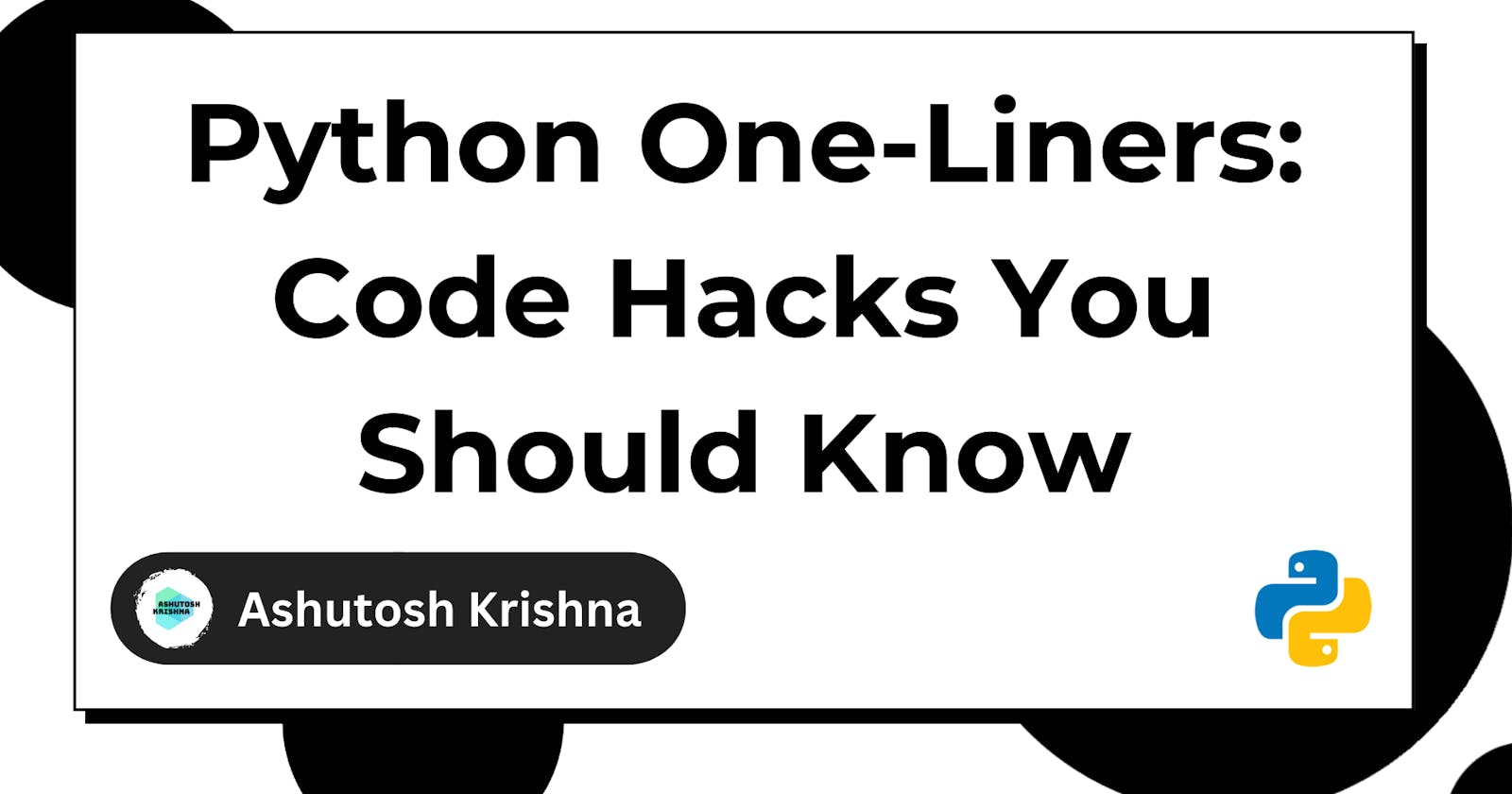Python's beauty lies in its simplicity and readability. And mastering the art of writing concise yet powerful code can significantly enhance your productivity as a developer. I'm talking about really short lines of code that do big things.
In this article, we'll explore 8 essential Python one-liners that every Pythonista should have in their toolkit. From list comprehensions to lambda functions and beyond, these techniques offer elegant solutions to common programming challenges, helping you write cleaner, more efficient code.
List Comprehension
List comprehension is a Pythonic way to create lists with a single line of code. It offers a concise alternative to traditional loops, enabling you to generate lists quickly and efficiently.
Let's say you want to create a list containing squares of numbers from 0 to 9. Using a traditional loop, you'd do it like this:
# Using a traditional loop
squared_numbers = []
for i in range(10):
squared_numbers.append(i ** 2)
print(squared_numbers)
The traditional loop method requires more lines of code and explicitly defines the iteration process, appending each squared number to the list step by step.
On the other hand, list comprehension can achieve the same result in a single line, making the code more concise and readable. It condenses the loop into a clear, compact structure, generating the squared numbers directly into a list.
# Using list comprehension
squared_numbers = [i ** 2 for i in range(10)]
print(squared_numbers)
You can use list comprehensions when you need to apply a simple operation to every element in a sequence, such as transforming a list of numbers or strings.
You can learn how you can pack and destructure lists in Python here.
Lambda Functions
Lambda functions, also known as anonymous functions, allow you to create small, throwaway functions without explicitly defining them with def. They are particularly useful in scenarios where a function is needed for a short operation.
First, let's look at an example using def:
# Using def
def add_numbers(x, y):
return x + y
print(add_numbers(2, 3))
In this code, the def keyword is used to define a named function add_numbers explicitly. It takes an argument x and y and returns the sum of them. This traditional approach provides a named function that can be called multiple times.
But when you need a function just for one-time usage, you can just define an anonymous function using the lambda keyword like this:
# Using Lambda
add = lambda x, y: x + y
print(add(2, 3))
It achieves the same result as add_numbers but in a single line without assigning a name explicitly. Lambda functions are useful for short, throwaway functions that are used infrequently or as part of other expressions.
Map and Filter
The map and filter functions are powerful tools for working with iterables, allowing concise manipulation and filtering of data.
Let's say you have a list of strings and you want to convert each item of the list into uppercase.
fruits = ['apple', 'banana', 'cherry']
upper_case_loop = []
for fruit in fruits:
upper_case_loop.append(fruit.upper())
print(upper_case_loop)
Now, you can achieve the same using the map function:
upper_case = list(map(lambda x: x.upper(), ['apple', 'banana', 'cherry']))
You can utilize map when you need to perform an operation on every element of an iterable. filter is handy for selectively choosing elements based on a condition.
You can learn more about the map, filter and reduce functions here.
Ternary Operator
The ternary operator provides a condensed way to write conditional statements in a single line, enhancing code readability.
Let's say, you have a number and you want to check if it's even or odd. You can do it using the traditional if condition as below:
# Traditional if
result = None
num = 5
if num % 2 == 0:
result = "Even"
else:
result = "Odd"
But you can achieve the same results in a single line using the ternary operator:
# Ternary Operator
num = 7
result = "Even" if num % 2 == 0 else "Odd"
When you need to assign values based on conditions, especially in situations requiring simple if-else checks, the ternary operator shines.
Zip Function
The zip function enables you to combine multiple iterables element-wise, forming tuples of corresponding elements.
Let's assume you have two lists: one containing the names of students and the other containing their respective grades for a specific assignment.
students = ['Dilli', 'Vikram', 'Rolex', 'Leo']
grades = [85, 92, 78, 88]
Now, you want to create a report that pairs each student's name with their grade for easy comprehension or further analysis. You can do it by iterating over the list and appending them to a new list as below:
students = ['Dilli', 'Vikram', 'Rolex', 'Leo']
grades = [85, 92, 78, 88]
student_grade_pairs = []
for i in range(len(students)):
student_grade_pairs.append((students[i], grades[i]))
print(student_grade_pairs)
The above loop method manually pairs elements from two lists by iterating through their indices, accessing elements at the same positions, and appending tuples of those elements into a new list student_grade_pairs.
But, what if I tell you that we can achieve the same pairing effect in one line using the zip function as below:
students = ['Dilli', 'Vikram', 'Rolex', 'Leo']
grades = [85, 92, 78, 88]
student_grade_pairs = list(zip(students, grades))
print(student_grade_pairs)
The zip function elegantly combines elements from both lists, creating pairs of corresponding elements as tuples. The result student_grade_pairs is a list of tuples, where each tuple contains an element from the grades list paired with the corresponding element from the students list.
You can learn more about the zip function here.
Enumerate Function
The enumerate function offers a concise way to iterate over a sequence while keeping track of the index.
Let's say you're developing a feature where users can add items to their shopping list, and you want to display the items along with their position or index in the list for easy reference.
You can do it using a traditional for-loop as below:
# Simulating a grocery list
grocery_list = ['Apples', 'Milk', 'Bread', 'Eggs', 'Cheese']
# Displaying the grocery list with indices
for i in range(len(grocery_list)):
print(f"{i}. {grocery_list[i]}")
The traditional loop with manual indexing involves using range along with len to generate indices that are then used to access elements in the grocery_list list. This method requires more code and is less readable due to the explicit handling of indices.
The enumerate function simplifies the process by directly providing both indices and elements from the grocery_list list.
# Simulating a grocery list
grocery_list = ['Apples', 'Milk', 'Bread', 'Eggs', 'Cheese']
# Displaying the grocery list with indices
for index, item in enumerate(grocery_list):
print(f"{index}. {item}")
It's concise, readable, and more Pythonic, eliminating the need for manual index handling and making the code cleaner. This approach is generally preferred for its simplicity and clarity in obtaining indices and elements from an iterable.
String Join
The join method is a clean way to concatenate strings from an iterable into a single string.
Suppose you have a list of words and want to create a sentence by joining these words using traditional concatenation. You'd do it as below:
# Using traditional concatenation
words = ['Python', 'is', 'awesome', 'and', 'powerful']
sentence = ''
for word in words:
sentence += word + ' '
print(sentence.strip()) # Strip to remove the trailing space
In the traditional concatenation method, a loop iterates through the list of words, and each word is concatenated with a space. However, this approach requires creating a new string for each concatenation operation, which might not be efficient for larger strings due to string immutability.
The join method, on the other hand, is more efficient and concise. It joins the elements of the list using the specified separator (in this case, a space), creating the sentence in a single operation.
.# Using join method
words = ['Python', 'is', 'awesome', 'and', 'powerful']
sentence = ' '.join(words)
print(sentence)
This method is generally the preferred way to join strings in Python due to its efficiency and readability.
Unpacking Lists
Python's unpacking feature allows for efficient assignment of elements from iterables to variables.
Suppose you have a list of numbers, and you want to assign each number to separate variables using traditional indexing.
# Using traditional unpacking
numbers = [1, 2, 3]
a = numbers[0]
b = numbers[1]
c = numbers[2]
print(a, b, c)
In the traditional unpacking method, individual elements from the list are accessed and assigned to separate variables by explicitly indexing each element. This method is more verbose and requires knowing the number of elements in advance.
Now, let's accomplish the same using the * operator for unpacking the list into variables.
# Using * operator for unpacking
numbers = [1, 2, 3]
a, b, c = numbers
print(a, b, c)
You can learn more about the * operator and list unpacking in this tutorial.
Should You Always Use One-Liners?
While Python one-liners offer conciseness and elegance, there are considerations to keep in mind before applying them universally:
Readability: One-liners might sacrifice readability for crispness. Complex one-liners can be hard to understand, especially for newcomers or when revisiting code after some time.
Maintainability: Overusing one-liners, especially complex ones, can make code maintenance challenging. Debugging and modifying concise code might be more difficult.
Performance: In certain scenarios, one-liners might not be the most performant solution. These concise expressions may consume more resources, such as memory or CPU, and their underlying operations might have higher time complexity, affecting efficiency, especially with large datasets or intensive computations.
Debugging: Debugging a one-liner can be more challenging due to its compactness. Identifying issues or errors might take longer compared to well-structured, multiple-line code.
Context: Not all situations warrant one-liners. Sometimes, a straightforward, explicit approach might be more suitable for code clarity, especially when working in teams.
Ultimately, the decision to use one-liners should consider the trade-offs between conciseness and readability. Strive for a balance that enhances code clarity without compromising maintainability and understanding, especially when collaborating or working on larger projects.
Wrapping Up
Mastering Python's concise techniques like list comprehensions, lambda functions, enumerate, join, zip, and unpacking with the * operator can significantly enhance code readability, efficiency, and simplicity. These methods offer elegant solutions to common programming challenges, reducing verbosity and improving code maintainability.
Understanding when and how to use these Pythonic constructs empowers developers to write cleaner, more expressive code and enhance overall productivity in various programming scenarios.

